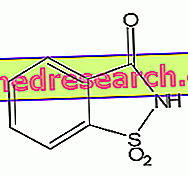Generality
The bursitis of the elbow is the inflammation of the synovial bursa located near the olecranon of the ulna and forming part of the joint of the elbow.

The typical symptoms and signs of an elbow bursitis consist of: swelling, pain and difficulty in movement.
In general, the diagnosis is based on physical examination and medical history; rarely, doctors resort to more thorough examinations.
The first line treatment is conservative. The use of more invasive treatments (surgery) occurs only when conservative therapies have not provided the desired results.
Short reference to the anatomy of the elbow
The elbow joint results from the relationship of three bone elements: humerus, ulna and radium.
The humerus is the arm bone; Ulna and radio, on the other hand, are the bones of the forearm.
At its distal end, the humerus has two characteristic areas: the so-called capitulum and the so-called humeral trochlea.
- The capitulum is the part of the humerus that articulates with the head of the radium . The head of the radium represents the most proximal end of this bone;
- The humeral trochlea is the part of the humerus which is articulated with a portion of the particular ulna, called olecranon . Very similar to a hook, the olecranon represents the most proximal end of the ulna.
What is elbow bursitis?
The bursitis of the elbow, or olecranon bursitis, is the inflammation of a particular synovial bursa of the elbow joint: the synovial bursa located near the olecranon of the ulna.
In normal conditions, the olecranon bag has a flattened appearance.
When it is inflamed and irritated, on the other hand, it swells - sometimes quite clearly - due to an accumulation of fluid inside it.
WHAT IS A SINOVAL EXCHANGE?
The synovial joints, such as the knee, the elbow, the ankle, the shoulder etc. - present a particular internal anatomy, which guarantees them a wide range of movement and, at the same time, protection from possible rubbing, traumas, etc.

A generic synovial bursa is a sac, lined with a synovial membrane and containing a liquid, known as synovial fluid .
Acting as anti-friction and anti-rubbing pads, the synovial bags have the task of preserving the ligaments, tendons, cartilaginous tissues and other anatomical structures of the synovial joints.
Causes
The causes of elbow bursitis include:
- The strong trauma of the elbow tip . The tip of the elbow is the prominent bony prominence between the arm and forearm; in fact, it is a portion of the olecranon of the ulna.
- Prolonged pressure at the tip of the elbow . Such pressure is what is created when an individual rests, for long periods of time and in a repetitive way, the elbows on a table, a desk, a rigid surface and so on.
The elbow bursitis resulting from prolonged pressure at the elbow tip forms very slowly, even over several months.
Particularly at risk of elbow bursitis with this particular nature are those who, for work, are forced to rest their elbows very often on hard surfaces (eg: plumbers, boilers, etc.).
- Infections following cuts, wounds and insect bites, at the level of the elbow.
In such circumstances, it is possible that germs and bacteria enter the synovial bag of the olecranon of the ulna and infect it, causing inflammation.
Elbow bursitis due to infection has characteristic clinical signs.
- Some forms of arthritis, such as rheumatoid arthritis or gout . In medicine, the term arthritis indicates the inflammation of one or more joints.
Symptoms and Complications
The most characteristic clinical sign of elbow bursitis is swelling, clearly at the level of the elbow. The extent of the swelling varies from patient to patient, depending on the severity of the inflammation of the synovial bursa. In general, the more obvious the swelling, the more severe the inflammatory state.

In severe cases, swelling and pain severely impair the ability of the elbow to move.
ELBOW PURSE DUE TO AN INFECTION: SYMPTOMS AND COMPLICATIONS
In addition to pain and swelling, elbow bursitis due to an infection are also responsible for: presence of pus, skin redness and a sense of heat, obviously at the level of the affected elbow.
Failure to treat an infectious bursitis of the elbow can lead to the spread of bacteria in the bloodstream, which have infected the synovial bursa near the olecranon.
The spread of these bacteria in the bloodstream can be the cause of unpleasant consequences and endanger those who are victims of it.
Diagnosis
In general, a physical examination and medical history are sufficient for a diagnosis of elbow bursitis and its causes.
The use of X-rays occurs only in case of suspected presence of an osteophyte at the level of the olecranon of the ulna. Osteophytes are small bone spurs, similar to a rose thorn, a beak or a claw, which form along the articular margins of bones subjected to erosive and irritative processes with a chronic character.
The collection and analysis of the fluid present in the swollen synovial bursa takes place only if there is the possibility that the bursitis is due to an infection or an episode of gout.
Identifying the precise causes of an elbow bursitis is essential for planning the most appropriate therapy.
Treatment
Treatment of an elbow bursitis depends on at least two factors:
- The intensity of the symptomatology e
- The triggering causes.
In general, doctors prefer a conservative (or non-surgical) type of therapy, reserving the right to resort to surgery (surgical therapy ) only if the conservative remedies have not provided any results (or the results provided are unsatisfactory and the patient continues to experience pain, swelling, etc.).
CONSERVATIVE THERAPY
Among the possible conservative treatments for the treatment of an elbow bursitis are:
- The aspiration, by needle, of the excess liquid, present inside the inflamed synovial bursa.
- Administration of antibiotics. This treatment is provided only when the cause causing the condition is an infection of bacterial origin.
Antibiotic therapy is essential to fight off infecting bacteria and prevents unpleasant consequences (eg: spread of bacteria in the blood).
- Use of an elbow pad. It is very useful especially for those elbow bursitis due to prolonged pressures.
- The suspension of all those activities that favor the appearance of an elbow bursitis.
- The administration of non-steroid anti-inflammatory drugs (NSAIDs). Ibuprofen is one of the best NSAIDs.
- Administration of corticosteroids by injection. Corticosteroids are powerful anti-inflammatory drugs, whose prolonged use could lead to several side effects. For this reason, doctors only prescribe them when NSAIDs are ineffective and the pain and swelling are still present.
SURGICAL THERAPY
The surgical therapy, foreseen in case of bursitis of the elbow, consists in the intervention of removal of the inflamed synovial bursa.
If the bursitis had an infectious origin, a post-operative antibiotic treatment is provided and at least one day of hospitalization.
If, on the other hand, the bursitis had a non-infectious origin, the patient needs nothing else and can return home the same day of the operation, usually a few hours after the end of the procedure.
In general, the recovery phase from bursitis of the elbow does not require special physiotherapy (but only some exercises that the patient can do at home) and has a canonical duration of 3-4 weeks.
Does the synovial bag reform?
Once removed by surgery, synovial bags tend to reform in their original location.
Reforming a synovial bursa is a very slow process, which takes many months.
Prognosis
As a rule, episodes of elbow bursitis tend to have a positive prognosis.
The use of surgery is quite rare and, however, surgery is now a safe therapeutic option.
It is important to remind readers that the success of the surgical procedure does not exclude future elbow bursitis (recurrence).
Prevention
Not all conditions that can cause elbow bursitis are preventable.
Having clarified this, avoid resting the elbows for long periods on rigid surfaces and protecting the elbows from possible trauma, during sports or work at risk, are the main preventive measures against elbow bursitis.



